December 28, 2024
Before our trip, when we told anyone we were going to India, their first question was, "Are you going to see the Taj Mahal?" Yes, of course! This UNESCO World Heritage Site is the #1 tourist attraction in India (although it is being overtaken by a city I haven't heard of--Ayodhya--308 miles to the east). UNESCO declared it "the jewel of Islamic art in India and one of the universally recognized masterpieces of the world's heritage." It was also named one of the "New 7 Wonders of the World" in 2001. Taj Mahal is Hindi for "Crown Palace." It is interesting to note that out of the 7 to 8 million visitors it hosted in 2024, less than 1 million were international tourists and the rest were domestic.
To get to "the Taj," as it is fondly called, you first have to pass through the Monkey Guard, a long walk from the parking area to the Taj itself that is guarded by aggressive macaque monkeys.
There are a lot of them, both underfoot . . .
. . . and overhead.
Tourists are given plenty of warning to use caution around the monkeys. The sign at right has five bullet points of advice. I should have paid more attention to the one that says "Don't make direct eye contact with monkeys." More on that at the end of this post.
Our first glimpse of one of the structures on the Taj Mahal property included a monkey.
We caught a glimpse of the Taj Mahal dome before we even entered the gate.
The Taj complex is surrounded by crenellated red sandstone walls on three sides with the fourth side left open to the Yamuna River, just like the Baby Taj described in my last post. Only the king could enter the complex from the river. Everyone else entered through one of the gates.
There are five entries to the Taj Mahal complex. The
main gateway was built between 1632-1638 and is believed to have been designed by the same architect who designed the Taj itself, Usstad Ahmad Lahauri. It is 93 feet high and 150 feet wide.
I like the 11 miniature marble cupolas that top each side of the large central wall and the four larger cupolas on each corner that tie this building style-wise to the Taj. The red sandstone is complemented by sections of white marble with inlaid semi-precious stone motifs of flowers, leaves, and vines that reflect the impact of the Hindu culture on Mughal architecture. The gateway itself is really a building with multiple rooms, and as a transition from the outer world to the inner world of the spirit, it is symbolic of the gate to Paradise. The interior has a beautiful vaulted ceiling.



As I mentioned in my last post, Islamic architecture does a superb job of framing images, which, 500 years later, makes a perfect photography opportunity. In the Taj complex, the first sight the famous mausoleum framed in the pointed arch is a stunner. Stepping through the gate is indeed like entering Paradise--except for the mass of very earthly bodies. Getting there at 8:30 AM didn't seem to help much, but of course we didn't see how much more crowded it was at 2:00 in the afternoon. I can only imagine.
This may be the only time on our trip that the smog actually added to the ambience. We could
almost imagine that there was an ethereal mist swirling around the Taj. Almost.
But rather than bask in that ethereal ambience, we got snagged by a photographer who was commandeering a bench with a good view of the Taj behind it. We figured a few "professional" photos would be fun, so we each took our turn. He must have taken 50 photos of each couple.
Some of the poses were pretty cheesy, but some were more traditional, and we agreed to buy a booklet of thirty 6x8 photos and the digital versions of all the photos, which he would have waiting for us after we were done sightseeing around the complex and ready to exit. I think the price was somewhere around $40 for all of that.


True to his word, we were met near the exit by a man with our booklets.


I'll include a few of the less cheesy pictures of Bob and me at the end of this post.
The Taj and surrounding grounds really are beautiful, but perhaps the reason they have captured the world's attention is less because of the physical beauty and more because of the love story that inspired them.
It begins with the marriage of Shah Jahan, the fifth Mughal emperor and probably the greatest builder of the Mughal era, and Mumtaz Mahal. She was actually his second wife, but he was particularly devoted to her, and she bore him fourteen children, of which seven lived to adulthood. Mumtaz died of postpartum hemorrhage at age 38 after giving birth to the fourteenth child on June 7, 1631. Shah Jahan was so devastated, historians note, that he was paralyzed by his grief and given to weeping fits.
Mumtaz was buried in a garden built by Shah Jahan's uncle, but almost immediately her bereft husband commissioned a more majestic way to honor his beloved. Construction began in 1632 and was completed in 1648, with the surrounding gardens and buildings being finished in 1653. About 20,000 laborers and artisans worked on the project, and the total cost at the time was 32 million rupees, or about $827 million in today's US dollars. Early in the construction process, Mumtaz's body was moved to the grounds and buried in a corner of the garden, but eventually she was permanently interred beneath the Taj.
When Shah Jahan died in 1658, twenty-seven years after the love of his life, he was buried next to her in the Taj. Today their cenotaphs lie side-by-side in the heart of the palace.
But before I get to the tombs, let me begin with the grounds, which are divided into four quadrants by two long walkways. Additional paths divide each quarter into four more quarters. Unlike other garden tombs in India, the Taj is located at the end of the garden rather than at the center.
This water feature runs north-south between the Taj and the main gate and serves as a reflecting pool for the Taj, but unfortanately I didn't realize that and didn't get that photo. This view is looking from the Taj back toward the main gate.
Another long canal runs east-west between two identical pavillions known as the Water Palaces (Jal Mahal). They are built of red sandstone except for the white marble raised cupola on top.
So back to the star of the show. This is probably the best photo I got when we were there. Note the number of people not just in front on ground level, but also on the platform that the Taj rests on. Compare the size of the tiny people on the platform to the four towering minarets. Unfortunately, we were not allowed to take pictures inside, but I'll include a few from the internet later in the post.
You can see from the photo below that the Taj is essentially a square building with the corners cut diagonally to form an octagon. The perfectly symmetrical octagonal shape and four minarets, as opposed to a rectangular building with a minaret on each end, enhances the three-dimensionality of the building. The Taj is about 240 feet high (the onion-shaped dome itself is 75 feet of that), with the four main sides measuring188 feet long.
The huge main entrance, know as the Darwaza-e Rauza (Great Gate), is a 108-foot-tall arch-shaped doorway that has a border of graceful Arabic calligraphy. The inscription "invites the reader to enter Paradise, the abode of the faithful and reward for the righteous." The words come from one of the Surahs (chapters) in the Quran.
Looking up inside the arch:
I was impressed to see this explanation of the Taj on site in what at first I thought was also Arabic but then realized was Braille.
In many of my photos, the minarets are distorted to look as if they are leaning inwards, Pisa style, towards the mausoleum. However our guide told us that they actually lean just a few degrees outward, away from the mausoleum, so that if they ever collapse (during an earthquake, for example), they would fall away from the main structure.
The minarets are 130 feet tall, the equivalent of an 11-storey building. I would have loved to climb the stairs to the top, but I'm guessing that isn't part of the regular tourist ticket price. By the way, Indian citizens pay ₹50 (about 58¢ for a ticket to the Taj, and foreign tourists pay ₹1,100 (almost $13--still cheap). There is an additional fee of about $2.25) to enter the main mausoleum. Children under 15 are free.
The marble of the mausoleum and the red stone used in the other buildings are joined together to form the flooring surrounding the Taj. The short fence is made of carved red stone.
The embellishments on the white marble Taj are pretty amazing. You can see that some areas are quite worn down and others have been replaced in the restoration process.
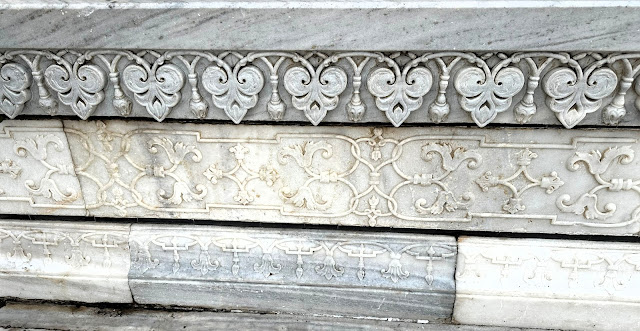
Remember, there is no paint. Any color is inlaid semi-precious stone. No space is left unadorned.
I've taken three photos from the internet of the interior room that holds the cenotaphs (a ceremonial marker erected to honor the remains of someone buried elsewhere) of Shah Jahan and Mumtaz Mahal. This may be the only thing about the Taj Mahal that is not perfectly symmetrical. Mumtaz was interred first, and her tomb is centered. Perhaps when they added Shah Jahan's tomb 27 years later, it was just easier to leave Mumtaz's marker where it was. By the way, the actual tombs are in the crypt beneath the main chamber. Generally, tourists are not allowed to enter that room.
Note the size difference. Of course the larger tomb belongs to the emperor Shah Jahan and the smaller to his beloved, Mumtaz Mahal.
Back outside, we noticed a building off to one side of the Taj that we learned is the Taj Mahal Mosque. Our guide told us that it is open to local residents for Friday prayer. In fact, the Taj Mahal is closed to tourists all day on Fridays.
It appears to be popular to take a photo from the Taj platform with the mosque in the background.
Well, after several hours of wandering the grounds and exploring the interior of the Taj, it was time to move on to another destination. It was definitely more crowded when we left than when we arrived.

Good-bye, Taj Mahal!
Here are a few photos from our photo shoot:
These are fun memories and I'm glad we spent the little bit of money that they cost.
Okay, remember those monkeys on the way in and the sign that said not to get too close for photos or to look one in the eyes? Yeah, I didn't really take it too seriously. This monkey did NOT want its picture taken and did not like me even looking at it. It actually hissed at me and charged me. It was terrifying!
In stark contrast are India's stray dogs, which never approached us, and in fact rarely seemed to get up on all fours.
On our way out of Agra we stopped by a factory where artisans use ancient techniques of stone cutting to create beautiful stone mosaics.
Four men sitting cross-legged on the floor in a large room were bent over their work. One showed us how they pull the nacre out of a shell--the iridescent layer that lines some mollusk interiors. We saw surfaces that had been partially covered with tiny bits of semi-precious stone.
When I say "tiny bits," I mean it. Look at the miniscule pieces this artisan is going to fit into his work. On the left are two petals, and on the right are the pieces that will become stems.
This is the same craft that was used to create the intricate inlaid wall patterns in marble buildings like the Taj Mahal and Baby Taj.
Replicas of the same design are made before they are placed into the larger design. I think the artisan traces the shape onto his slab of marble, cuts out the shape, and places the design in the negative space. It has to be a perfect fit to create the polished surface that makes these designs so beautiful.
Today's tools are very similar to the tools that were used hundreds of years ago to create these masterpieces.
We purchased this 13" octagonal plate that can serve as a table top, but we bought a turntable to turn it into a lazy susan instead. Pretty stunning, isn't it? They swaddled it in bubble wrap for us, and it made it home intact.

























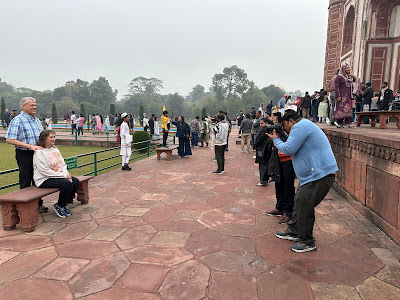



















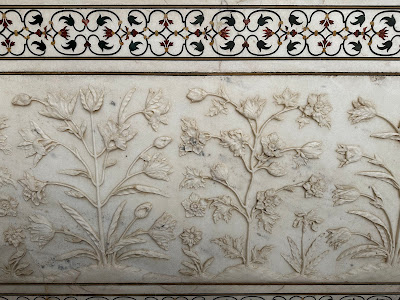











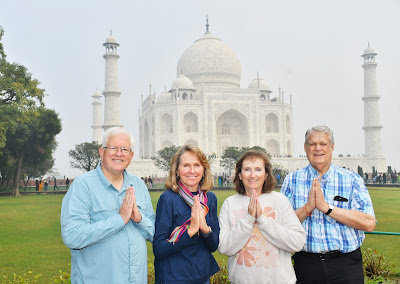




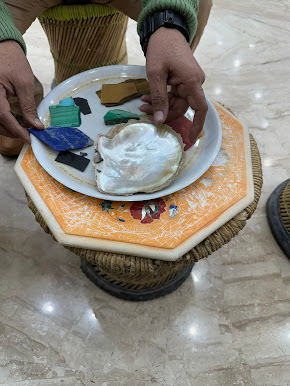
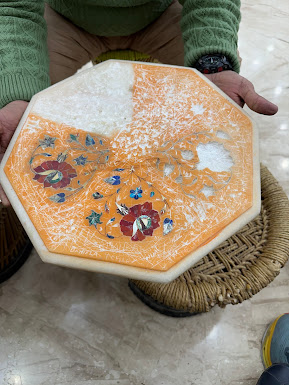








(Bob) I can say that I did not have a lot of interest in visiting the Taj and I was pleasantly surprised that I liked it as much as I did. It truly is magnificent. The art of inlaid stone in marble was fascinating and the works of art incredible. I enjoyed our demonstration very much and seeing the various pieces of artwork. I generally enjoyed the art making demonstrations in India as much or more than the monuments.
ReplyDelete